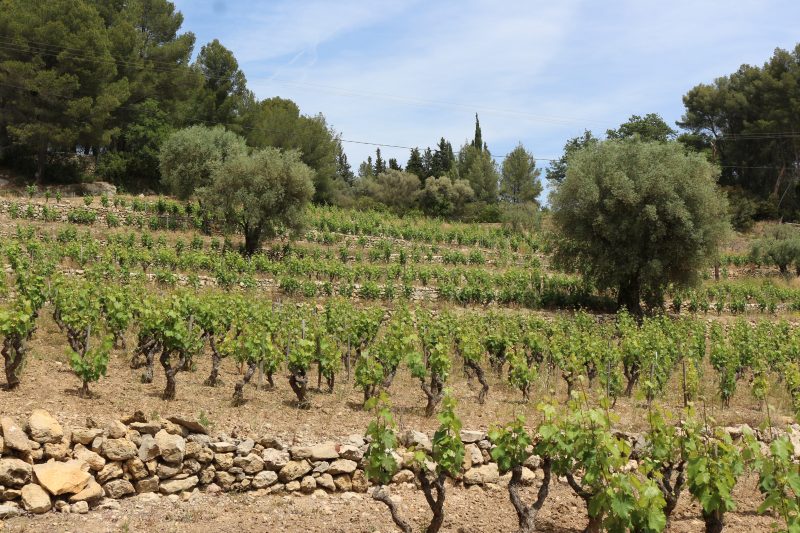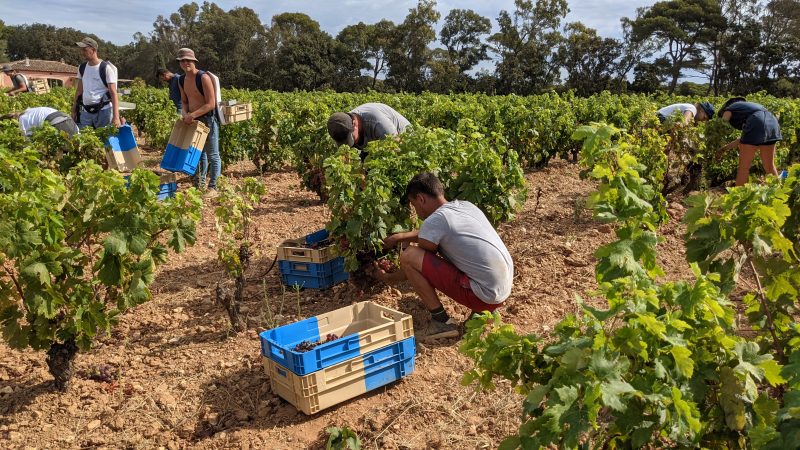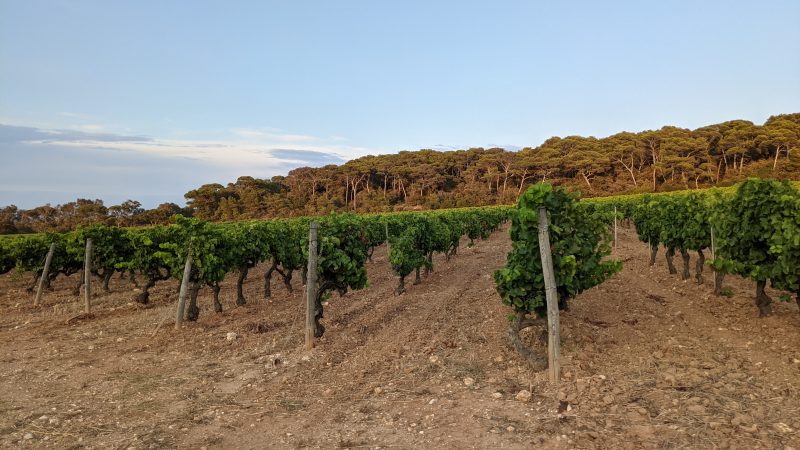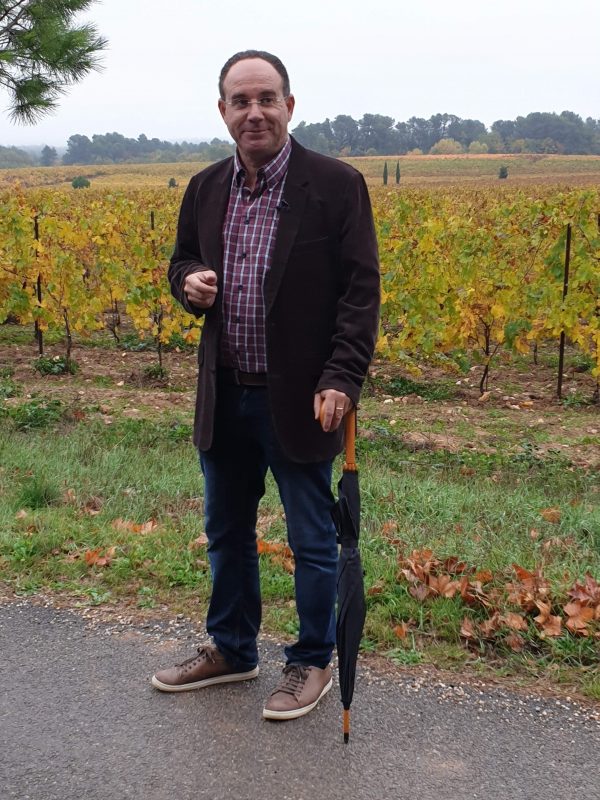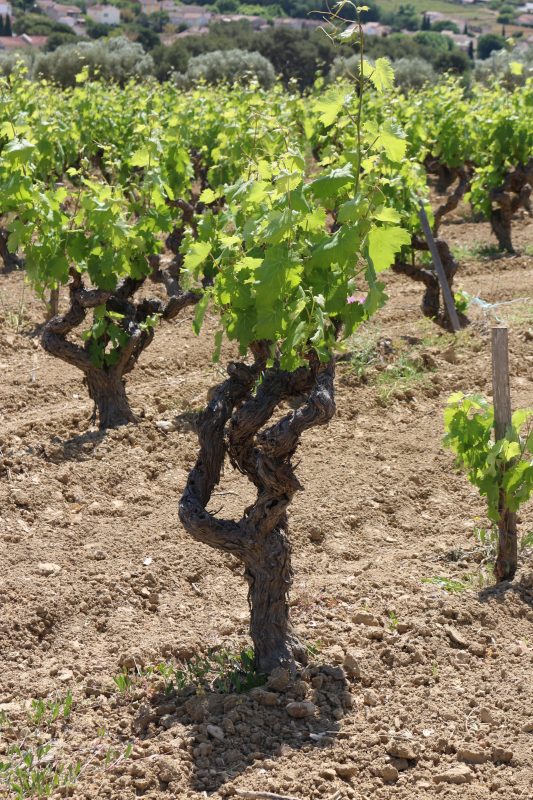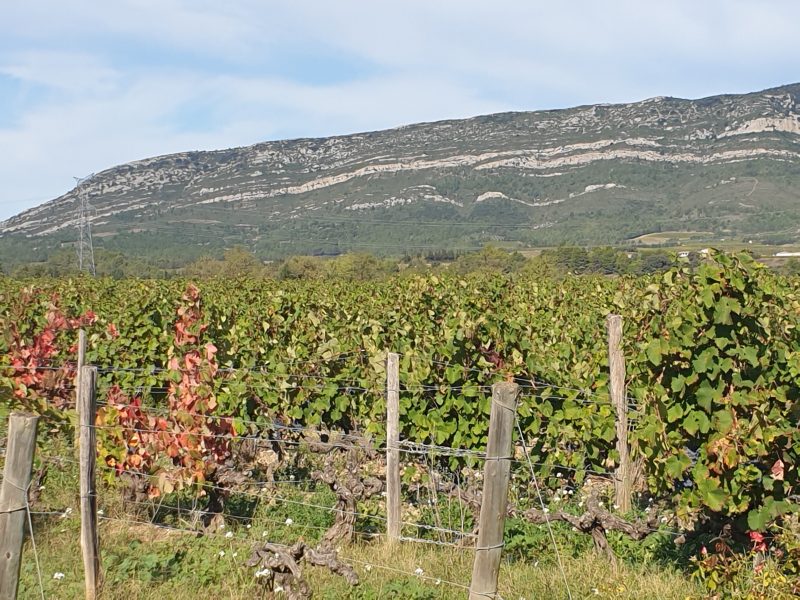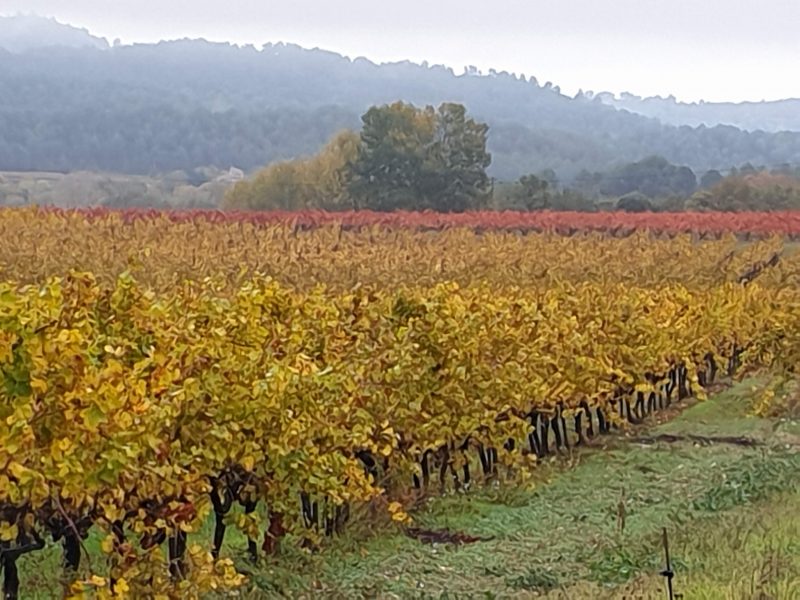Today, Provence conjures images of pale rosé wines, but that hasn’t always been so. Back in the 1980s it was a region of reds, rosés and whites – like any other. Not particularly fine, elegant wines on the whole, but hearty, rustic reds with a good dose of Carignan mixed with Grenache; clunky, slightly oxidative whites made of Ugni Blanc, Clairette and some Sémillon; along with somewhat crude rosés. This was an era of rapidly improved winemaking, and unlike many other regions, Provence implemented these improvements in all three colours. But, when the newly clean and fresh rosé took off commercially, the reds and whites were left behind.
Current estimates suggest that Provence is 80-90% dedicated to rosé, but this only gives half the story. The mega-big rosé producers (d’Esclans, Minuty, Miraval, Mirabeau, MDCV – to name some of the largest) focus almost entirely on rosé, which slants the statistics. Dig a little deeper and there is a wealth of smaller family estates still producing good quantities of red and white wines close to the hearts of the region’s vignerons. Despite the proximity and overlap with parts of the Rhône valley or even the Languedoc, Provence’s reds and whites are, especially today, very distinct – both in style and varietal make-up. These wines are rarely exported, found instead on wine lists in restaurants across the region. The quintessential Provencal bistro serves not rosé, but local reds and whites.
Initially, these were hearty carafe wines, but in the 1970s, Domaine Vignelaure and then Trevallon
pioneered a new ‘Provence-style’ blend for reds: 50% Syrah and 50% Cabernet Sauvignon. Neither variety was indigenous to Provence, but both made the most of the area’s abundant sunshine, delivering unusually ripe, fruity wines. Today, almost half of the region’s top reds are made from these Syrah-Cabernet blends, and most of the rest are Syrah-majority anyway. They have relatively little Cabernet Sauvignon typicity, but do tend to be full-bodied and fruity, although somewhat less ‘opulently big’ than the reds of the Languedoc, combining the spice of Syrah with the cassis fruit of the Cabernet. Oak is invisible, and these are usually drinkable quite a bit younger than you would expect.
Exceptions, of course, exist and, to quote Astérix and Obélix, “a small village of irreductible Gauls resists”: Bandol, famous for its love of Mourvèdre stands out, accompanied by a large swathe of neighbouring coastal Côtes de Provence, from La Londe to Saint Tropez and even including Fréjus. With climate change, Mourvèdre is being found increasingly further inland. These are usually wines to look out for, and are the most recognisably Provencal in the glass. Oak is a little more common here, along with Mourvèdre’s characteristic leather and black, inky spice – these are serious, age-worthy wines. Winemakers bemoan the transition to rosé away from the reds in this area, but do, usually on condition of anonymity, claim that this only leads to better reds as it is always the worst Mourvèdre parcels that first go to the rosé.
Carignan and the stereotypically southern French GSM (Grenache-Syrah-Mourvedre) are relatively rarely found, although Grenache is not uncommon, especially in the more Rhône-influenced northern parts of Provence such as the Luberon. These are usually excellent, as well as being rather better value for money. Sadly, Grenache is more frequently used in rosé, but can offer vibrantly fresh reds. Cinsault, Provence’s second most widely-planted grape variety (and a delightful one at that!) is too quickly snapped up for the rosés, and, with one or two notable exceptions, almost entirely absent from the reds.
White wines are slightly simpler, with most of the region’s former diversity reduced over the last two decades to Rolle, accompanied by small amounts of Clairette (especially on the coast and around Bandol), Ugni Blanc, some Sémillon and Sauvignon Blanc, and, especially further north, Grenache Blanc and Roussanne. Two distinct styles exist today, with wines split between fashionably crisp-and-fresh, very much in the same family style as their pink cousins, and the traditional and much more serious later-harvested, oak-aged, intensely nutty and waxy whites that share little with the region’s rosés and which generally enchant with their richness and complexity. Rolle works well in both styles, although Clairette, Roussanne, Sémillon and Grenache Blanc are much more enjoyable when harvested slightly later. Top white regions include the wines of Sainte Victoire (beloved of Cézanne) with its higher elevation and limestone soils, the higher plateau of Coteaux Varois, northern Coteaux d’Aix and the southern slopes of the Luberon.
Provencal oak-ageing is traditionally invisible, relying on old foudres (very large oak barrels that can fill an entire room) and boutes, the Provencal equivalent of a demi-muid, about 600L. Rare are barrel rooms filled with gleaming new bordelais barriques. These large, old barrels convey tremendous ageing potential to the wines, and it is not rare to find five or even eight year-old wines for sale here. A steady growth in cement tanks and jarres fits well with the more restrained profile of the region’s wines. Richer full-bodied fruitier wines with more obvious oak are generally regarded as being made for the export market by local traditionalists.
For many years the red wines of Provence have come second to the region’s rosé, but the white wines are seeing a revival of fortune with growing interest from consumers. While red wines declined in the 1990s as the grapes were channelled into rosé, this new white trend poses some interesting challenges. Provence rosé often has a healthy dose of white varieties giving the wines their classic paleness and body. Will we see a shift in styles as some white grapes are used for white wines until greater volumes are planted?
Exploring the reds and whites of Provence reveals a secret world, behind the public world of rosé, that is definitely worth exploring further. There are plenty of gems to discover outside of the traditional appellations and away from the big producers.

Philippe Bru, Vignelaure winemaker 

Reds
Léoube Secret de Léoube 2018, Cotes de Provence
50% Syrah, 25% Cabernet Sauvignon, 15% Grenache, 10% Cinsault
This British owned estate (literally on the beach!) shows the full ripeness of this region. Juicy, floral, luscious fruit. Rather beautiful and charming and very distinctly different. Smooth black berries, supple tannins, blue flowers, ripe fruit, long fresh length. Not a big wine but lovely balance. The two principal varieties seem beautifully integrated and complimentary from the leafiness at the start to the inky minerality on the finish. Lots of Syrah elegance, spice, leathery minerality, the structure is incredibly pretty – floral, juicy, crunchy.
Domaine Bunan Charriage 2020, Bandol
The ultimate expression of Bandol, this wine is 98% old vine Mourvèdre.
Forget the statistics shouting that Bandol has gone pink, this is the real soul of the region and the true love of all of the producers. From a restrained start on the nose of schistous minerality, incense and a touch of smoke this wine opens up to opulent black fruit with richly jammy, mulberries and plums with some black textured tannins and some balanced sweet sour acidity giving length and freshness. It’s firm, serious, sombre and mysterious, the oak presence discreetly indicated with notes of pot pourri, cedar and softly oaky tannins. This wine doesn’t shout – it whispers. And it whispers class.
Sylvain Morey St Jean 2020, Luberon
98% Grenache Noir + 2% Cinsault (with single variety reds not allowed in the appellation, a token 2% of Cinsault is added to the Grenache.)
Before rosé was a big success story, the region of the Luberon, on the cusp between the Rhone and Provence, chose to align itself with the Rhone – where it has since been somewhat overlooked. For many, however, it is very much part of the region of Provence, and so I have included this red, made by a Burgundy producer. It shows the pleasing contrast flavours gained from a cooler region within Provence. Lots of crunchy redcurrants, cherries and sour plums with silky supple mulberry and blackberry juiciness, firm textured tannins and very long mouthwatering acidity, with a salty and crushed black pepper finish. An easy, approachable wine with power and concentration and totally different to most Provence reds.
Chateau Vignelaure Edition S 2015, Coteaux d’Aix en Provence
From the ‘grandfather’ of Provence red wines, now in the capable hands of Philippe Bru, comes this Syrah-Cabernet Sauvignon wine from the northern heights of Coteaux d’Aix, across the Durance river from the Luberon. This special edition is made from a parcel selection of old vines and the intensity shows. Violets, black fruit, lots of spice with blue-black inky structure, and mouthwatering vibrancy. Grainy textural tannins and behind it some big deep black fruit waiting to emerge. The Cabernet emerges with some fresh elegance and florals. Closed, young, elegant, but clearly concentrated and ripe. Acidity is good – still a young wine with lots of potential. Worth decanting to get the full power of this wine if drinking now.
Domaine de la Font des Pères La Reppe 2019, IGP Mont Caume
This Bandol producer has chosen to make an unusual red from 100% Carignan – making this wine fall outside of the Bandol appellation. Old vine Carignan wines have taken on cult status in Languedoc-Roussillon – it’s good to see producers in Provence being creative. From being a workhorse variety, its once ill-considered acidity is now highly valued. The rich, dark, spicy fruit is unctuous, shouting out about its ripeness and coastal location. Its crunchy, elegant, blood orange zesty acidity gives freshness while weight is supported by ripe intense tannins.
Whites
Domaine Éole Confidence 2019, IGP Alpilles
From the northern slopes of the limestone hills under the fortress of Les Baux in north-western Provence comes this 100% Roussanne which has more than a passing nod to similar style wines from the Rhone.
Beautiful lime and tropical bruised orange aromatics with intense floral notes are a great start to this wine which plays with sweet honey, salted limes, apples, pears, melons, hints of pineapple and almonds and creamy oak. I hate fruit bowl tasting notes, but this wine throws layers of fruity complexity at you. Creamy honeyed and edgy saline minerality gives an almost austere linear structure leading to crisp, clean vibrantly fresh acidity. The oak supports the weighty roundness. This wine is serious, fresh, big and ripe – it’s a real joy.
Domaine de Fontenille Cuvée Alphonse 2021, AOP Luberon
80% Rolle 10% Grenache Blanc 10% Clairette
Rolle – the southern French name for Italian Vermentino has swept across Provence over the past 30 years and is now the major white variety. Ripe and buttery with long lime and lemon acidity. Fresh herbs, sweet pineapple, tangerines – this is a fresh zingy white with rich power and a twist of floral delicacy. Salted lemons and structural oak add to the layers of interest. Despite the richness, it’s fresh and vibrant and surprisingly cool-climate. It may not be a bold wine, but it’s stunningly well made; its restraint doesn’t make it dull, it makes it whisper-smooth and you want to listen carefully to hear what it has to say.
Domaine de l’Ile 2021, Cotes de Provence
Rolle from the other side of the region – from the hottest and most southerly point on the island of Porquerolle on an estate owned by the perfume and fashion house Chanel. The hotter climate gives a creamy ripeness with pear and green apple fruit and a touch of apple blossom prettiness. Sour lime, salt and beeswax comes through on the finish with notes of wild fennel and garrigue. There is some sweet juicy intensity from ultra ripe fruit cut by zesty knife edge acidity – you can almost taste the salt of the sea.
Clos d’Alari Grand Rolle 2021, Cotes de Provence AOP
This 100% Rolle from central Provence gives another variation on the theme. The hot dry summer gives ripe fruit while ageing in acacia barrels gives less powerful structure. Ripe white fruit with white flowers, honeysuckle, white peaches, nashi pears and garrigue are surrounded by a ripe creaminess. The chalky acidity is crisp and zesty, the acacia gives a gently phenolic bitter almond finish. Fresh and prettily elegant in its youth, waiting to come forward with a more confident expression.
Les Beates Terra d’Or 2021, Vin de France
60% Chardonnay, 40% Sauvignon Blanc vin de France – and yes this is a Provence white! From Coteaux d’Aix where Sauvignon Blanc is proving to be quite successful. Sweet smoky pineapple with honey, salted pears, bruised apples and blossom prettiness. The minerality and oak is just enough to stop this wine becoming a simple fruity wine, giving a hint of pepper and garrigue on the finish. Saline, honeyed, creamy with crunchy orchard fruit. Wow! Seriously elegant and concentrated and a complete surprise.
Elizabeth Gabay MW grew up a Londoner but always travelled around Europe with her family. After back-packing around the world, Elizabeth returned to London where, by accident she fell into the wine trade when her parents bought a holiday cottage in Provence. Elizabeth passed the Master of Wine exam in 1998, and, in 2002, moved to a village an hour north of Nice. Her thirty years of working in Provence led in 2018 to her first book Rosé, Understanding the Pink Wine Revolution. With her son Ben Bernheim, they have put together an on-line Buyers Guide to the Rosés of Southern France, published in 2021. A new guide on the Rosés of Southern France, focusing on regional differences and old vintages was published in 2022. Elizabeth recently released a natural rosé called Sen (Dream) made with Slovakian producer Vladimir Magula.

